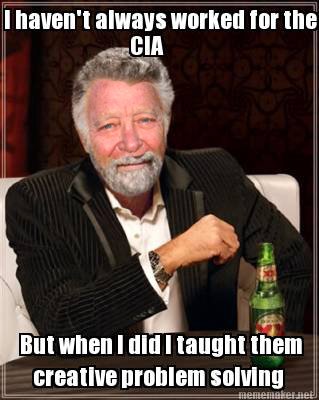The CIA, innovation and hay bales: creativity expert Michael Michalko connects the dots
We are stoked to have Michael Michalko contributing his experience and insights to Think Jar Collective. Michael is a world renowned creativity expert and has written a number of important books on the subject of enhancing creative thinking.
We're grateful he took the time to chat about his experience practicing and teaching creative problem solving over the last forty years. This is part one of a two part interview.
Ben Weinlick of Think Jar Collective:In reading a bit about your background, it looks like in your early career you got into creative problem solving through the US military and the CIA. That seems to me like a unique entry point into creative problem solving. Can you tell us a bit about how that came about?
Michael Michalko: I was temporarily assigned to NATO headquarters when I was a second lieutenant in the US Army. One day I was asked to facilitate a meeting of high ranking officers after the guest lecturer failed to arrive. Instead of presenting what the officers expected, I facilitated a brainstorming meeting using some basic creative thinking techniques I had self learned. It was a huge success. Some of the participants were high-ranking staff officers of the US 7th army. Consequently, I was immediately reassigned by the US 7th army to organize and facilitate think tanks designed to generate innovative and creative ideas for the US Army.
At that point I organized a team of US Army, NATO intelligence specialists, and international academics in Frankfurt, Germany, to research, collect, and categorize all known inventive-thinking methods. The purpose was to research methods and strategies to generate different ways of thinking for participants in brainstorming sessions. After the research stage was completed, I organized a team of army intelligence personnel to collate the research and to create step-by-step instructions on how the average person could use them. Our team applied those methods to various military, political, and social problems and produced a variety of breakthrough ideas and creative solutions to new and old problems the US Army, NATO and the CIA faced.
BW: Wow, that's unique. You might be the new candidate for the "most interesting man in the world"… I know you can’t talk about your work with NATO and the CIA, so maybe you could say a few things about what you see businesses and organizations struggle with when trying to become more creative?
MM: One of the biggest problems in the corporate world is the myth that creative people are born creative and others are not. This is perhaps why major corporate bureaucracies do so little to encourage or inspire creativity in all of their employees instead of a select few who are labeled creative.
Every one of us is born a creative, spontaneous thinker. The only difference between people who are creative and people who are not is a simple belief. People who believe they are creative and people who believe they are not are both right.
Once you have a particular identity and set of beliefs about yourself, you become interested in seeking out the skills needed to express your identity and beliefs. This is why people who believe they are creative become creative. They study and learn how to be creative.
If you believe you are not creative, then there is no need to learn how to become creative and you don’t. The reality is that believing you are not creative excuses you from trying or attempting anything new.
When someone tells you that they are not creative, you are talking to someone who has no interest and will make no effort to be a creative thinker.
What you are not taught in school
Another major problem in the business world is the fear of failure. MBAs are taught to only do what is orderly, predictable and logical. Do only what has been successful in the past and, above all, avoid surprises. It is no wonder that with all of the hundreds of thousands of MBAs that have graduated not one has started a new industry or a notable business. Instead innovation comes from college dropouts like Steve Jobs and Bill Gates.
We have been educated to think critically and judgmentally. Consequently, business people imagine strong reasons for inaction and then allow it to become their reality, even before they make an attempt. Our fear is supported by an illusion that it is possible to fail, and that failure means we are worthless. An example is the demise of Kodak. Kodak scientists invented digital photography and had several patents on the technology long before competitors were even aware of the possibilities. Top management at Kodak refused to even experiment with marketing what they had because they said, “We make our money with film and making film is what Kodak does and will do.” The CEO and top managers retired multi-millionaires with their golden parachutes and stock options leaving the company bankrupt and hundreds of thousands of employees around the world jobless.
The reality is that there is no such thing as failure. Whenever we attempt to do something and fail, we end up doing something else. You cannot fail, you can only produce results.
Rather than judging some result as a failure, ask "What have I learned about what doesn't work? Can this explain something that I didn't set out to explain? What can I do with these results? and What have I discovered that I didn't set out to discover?"
When Thomas Edison was seeking to invent the electric light bulb, he had thousands of failures. He would record the results, make adjustments and try again. It took him approximately 10,000 experiments to invent the perfect set-up for the electric light bulb. Once an assistant asked him why he persisted after so many failures. Edison responded by saying he had not failed once. He had learned 10,000 things that didn't work.
BW: There seems to be some controversy these days around brainstorming and whether it actually produces relevant results. What do you think about brainstorming? Is it still relevant? If you think it is, what should people keep in mind so that brainstorming brings about good results?
MM: The notion that the collective intelligence of a group is larger than the intelligence of an individual can be traced back to primitive times when hunter-gather bands would meet to discuss and solve common problems. It is commonly understood and an accepted practice. What's difficult is the willingness of a group to discipline itself to brainstorm for ideas openly and productively. Alex Osborne, an advertising executive in Buffalo, New York, recognized this and formalized brainstorming in 1941 as a systematic effort and disciplined practice to produce ideas in a group.
The way people retain their individuality while combining their efforts and talents is critical to creative collaboration.
Alex Osborne
Osborne's idea was to create an un-inhibiting environment that would encourage imaginative ideas and thoughts. The usual method is to have a small group discuss a problem. Ideas are offered by participants one at a time. One member records ideas and suggestions on a flip chart or chalk board. All withhold judgment. After the brainstorming session, the various ideas and suggestions are reviewed and evaluated and the group agrees on a final resolution.
There are many problems with traditional brainstorming. Sessions can be undercut by group uniformity pressures and perceived threats from managers and bosses. Other sessions fail because people find it difficult to avoid judging and evaluating ideas as they are offered. Personality differences also come into play: some people are naturally willing to talk, while others tend to be silent.
Group brainstorming, if done in the right spirit, can generate a rich variety of different perspectives and ideas about any given subject. That's because individuals are magically different and unique from each other and share few common associations. The way people retain their individuality while combining their efforts and talents is critical to creative collaboration.
Understanding that is vital to creating a cooperative synthesis. I have found that the following techniques are some of the best from around the world that are designed to help groups create a cooperative synthesis:
BRAINWRITING
Joseph Pelling animation
Horst Geschka and his associates at the Batelle Institute in Frankfurt, Germany, developed a variety of group creative-thinking techniques called Brainwriting which, like Feynman's innovative problem-solving approach, are designed to process ideas in parallel, spontaneous sequences. In traditional brainstorming groups, people suggest ideas one at a time. This is serial processing of information: i.e., only one idea is offered at a time in a series. Brainwriting, in contrast, allows multiple ideas to be suggested at the same time. This is parallel processing of information. If a brainwriting group has 10 members, up to 10 ideas will be generated for every one generated in a typical brainstorming session of 10 members. Brainwriting increases idea production dramatically.
The basic guidelines are:
First, discuss the problem to clarify it. Write the problem in a location visible to all group members.
Distribute 3X5 index cards to each participant and instruct them to silently write their ideas on the cards. One idea per card.
As participants complete a card, they pass it silently to the person on the right.
Tell the group members to read the cards they are passed and to regard them as a stimulation card. Write down any new ideas inspired by the stimulation cards on blank cards and pass them to the person on their right. Within a few minutes, several idea cards will be rotating around the table.
After 20-30 minutes, collect all cards and have the group members tape them to a wall. The cards should be arranged into columns according to different categories of ideas, with a title card above each column. Eliminate the duplicates.
Evaluate the ideas by giving each participant a packet of self-sticking dots and have them place the dots on their preferred ideas. They can allocate the dots in any manner desired, placing them all on one idea, one each on five different ideas, or any other combination.
You can design your own brainwriting format based on the two principles:
(1) Idea generation is silent.
(2) Ideas are created spontaneously in parallel.
BW: Why would you say creativity is important for people?
MM: What you think or believe is of no significance, the only thing of significance in life is what you do. Humans are blessed with a creative mind that enables them to continually improve life by overcoming adversity with creative ideas and innovative solutions. Though few of us realize it, one of the greatest ideas of all time was “hay.”
Invention of hay was an important creative act
In earlier times, civilization could exist only in warm climates where horses could stay alive through the winter by grazing. Without grass in winter you could not have horses, and without horses you could not have urban civilization. Most people accepted this as a law of nature, which to them meant humans were destined to live in warm climates.
At some point, some unknown farmer took action. He invented hay which was a way to bring food to the horses instead of bringing horses to the food. Forests were turned into meadows, hay was reaped and stored, and civilization moved north over the Alps. So hay gave birth to Vienna and Paris and London and Berlin, and later to Moscow and New York. Unless this unknown genius had acted and invented hay, civilization would not have prospered.
Think of what our world would be without creativity.
For part two of this interview and more creative problem solving techniques you can use in your work, keep connected with us by subscribing to our bi-weekly mailing list, and following us on Twitter and Facebook.
In the coming weeks Think Jar Collective will also share more creative problem solving techniques that Michael suggests.
You might be interested in
INTERVIEW WITH JAMES HAMMARHEAD: INTERSECTING NEUROSCIENCE AND MOTORCYCLE BUILDING
A 70 YEAR OLD CREATIVITY TECHNIQUE THAT IS STILL RELEVANT TODAY








